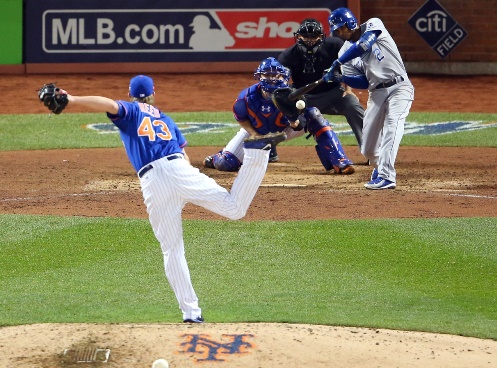One of the themes I’ve used over the years is that mistakes in baseball are often the result of a pattern recognition error. A.J. Pierzynski reaching base against the Angels in the 2005 playoffs is a great example, as was the poor umpire’s call in the Armando Galarraga near perfect game.
There was one Alcides Escobar swing during the World Series that stuck with me. I believe it’s the foul ball in this at bat. Watching it live, the broadcast crew was impressed that Escobar got wood on the ball, and the pitcher seemed to be a bit dismayed at the same thing. The pitch was well outside of the strike zone. It was a pitch that was designed to get Escobar to swing, but swing and miss. So when the pitch is properly executed and a different result happens, there is room for surprise.

Alcides Escobar makes contact for a double during the World Series. Photo: Anthony Gruppuso-USA TODAY Sports
The fielders see this as well. The spend a season behind a pitcher, learning what he throws, seeing the result of well executed pitches. The see a well executed pitch, and the pattern recognizer in their head is figuring out the most likely outcome; a grounder to short, a swing and miss, a fly ball to left. It happens so far they probably don’t realize what is happening, but they might even react to what they think is going to happen before the event occurs.
So what happens whey they see “swing and miss”, but suddenly the ball is coming at them? Are they as ready for it as they should be, or did the blown pattern recognition cause them to hesitate for a split second? Does the above foul ball play with their software, lowering the probabilities of other plays so they don’t react as well as they should?
I suspect trackman would be a good tool for studying this. Power hitters tend to swing at where they think the ball will go, contact hitters swing at the actual ball. Trackman might be able to tell them apart. Contact hitters tend to drag their bat through the strike zone, so they can adjust to a changing flight path (Tony Gwynn and Derek Jeter were that king of hitter). So a pitch that may be a swing and miss for most hitters in the league, suddenly is coming back at fielders for the type of hitters the Royals employ. The Royals owned a high BABIP, but few strikeouts and few home runs indicate they were not swinging hard. Disrupting the timing of the fielders might account for more balls than expected falling in for hits.


Interesting. Royals had a 68.8% O-zone contact rate which is higher than league average of 65.8%. Lot of them are probably fouls. The percentage of strikes put in play is 29.1% league wide, and the Royals are 32%. League strike percentage is 64%. The average team sees about 150 pitches a game, and 96 strikes. An average of 28 are in play for the average team, and 30-31 for the Royals, or 2-3 more for the Royals. There is an average 2/1 ratio of swinging strikes in the zone to out of the zone, so on average, the Royals may put 1-2 swings on balls out of the zone in play more than an average team.
Not sure how significant this is especially as other teams are most likely aware of the Royals contact abilities, but it may be.
I do think players position themselves and have expectations on where a ball will be hit based on the pitch and location and the teams scouting report. When a pitcher misses location badly and the ball is put in play, this may affect a fielders reaction, and result in a higher BIP due to a combination of positioning and reaction
Both could possibly have an impact on the defense. However, in the World Series, I really think it was just bad defensive play by the Mets by fielders who are not very good (eg Murphy), and perhaps the Royals speed on the bases contributed to this